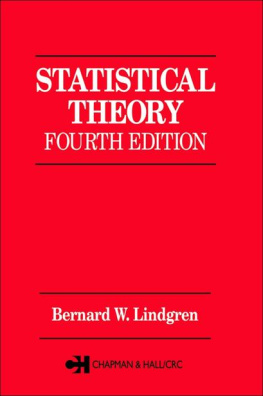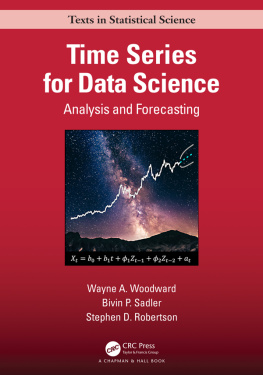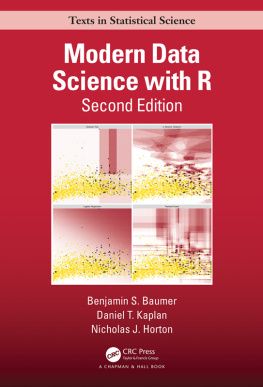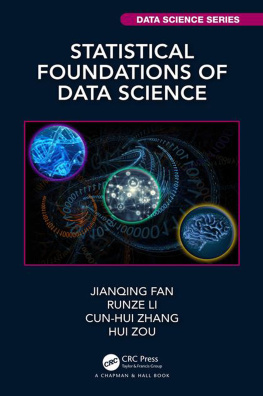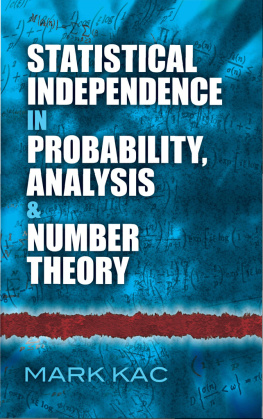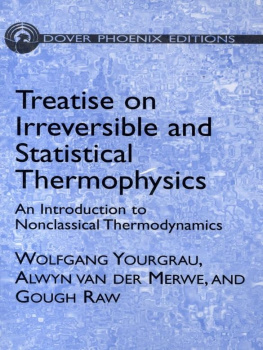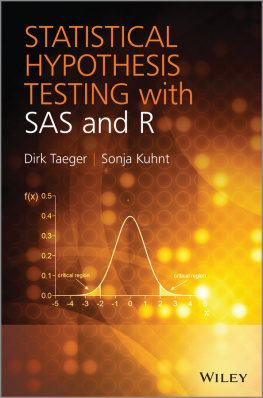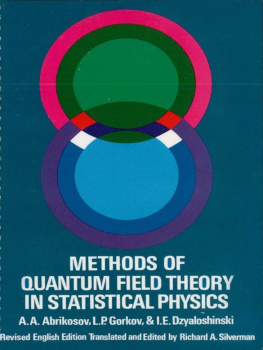Bernard W. Lindgren - Statistical Theory: 22 (Chapman & Hall/CRC Texts in Statistical Science)
Here you can read online Bernard W. Lindgren - Statistical Theory: 22 (Chapman & Hall/CRC Texts in Statistical Science) full text of the book (entire story) in english for free. Download pdf and epub, get meaning, cover and reviews about this ebook. year: 2017, publisher: CRC Press, genre: Children. Description of the work, (preface) as well as reviews are available. Best literature library LitArk.com created for fans of good reading and offers a wide selection of genres:
Romance novel
Science fiction
Adventure
Detective
Science
History
Home and family
Prose
Art
Politics
Computer
Non-fiction
Religion
Business
Children
Humor
Choose a favorite category and find really read worthwhile books. Enjoy immersion in the world of imagination, feel the emotions of the characters or learn something new for yourself, make an fascinating discovery.
- Book:Statistical Theory: 22 (Chapman & Hall/CRC Texts in Statistical Science)
- Author:
- Publisher:CRC Press
- Genre:
- Year:2017
- Rating:4 / 5
- Favourites:Add to favourites
- Your mark:
- 80
- 1
- 2
- 3
- 4
- 5
Statistical Theory: 22 (Chapman & Hall/CRC Texts in Statistical Science): summary, description and annotation
We offer to read an annotation, description, summary or preface (depends on what the author of the book "Statistical Theory: 22 (Chapman & Hall/CRC Texts in Statistical Science)" wrote himself). If you haven't found the necessary information about the book — write in the comments, we will try to find it.
Statistical Theory: 22 (Chapman & Hall/CRC Texts in Statistical Science) — read online for free the complete book (whole text) full work
Below is the text of the book, divided by pages. System saving the place of the last page read, allows you to conveniently read the book "Statistical Theory: 22 (Chapman & Hall/CRC Texts in Statistical Science)" online for free, without having to search again every time where you left off. Put a bookmark, and you can go to the page where you finished reading at any time.
Font size:
Interval:
Bookmark:

STATISTICAL THEORY
FOURTH EDITION
FOURTH EDITION
Bernard W. Lindgren

Library of Congress Cataloging-in-Publication Data
Lindgren, B.W. (Bernard William), 1924
Statisical theory/Bernard Lindgren. 4th ed.
p. cm.
Includes bibliographical references and index.
ISBN 0-412-04181-2
1. Mathematical statistics. I. Title.
QA276.L546
519.5dc20 93-1042
This book contains information obtained from authentic and highly regarded sources. Reprinted material is quoted with permission, and sources are indicated. A wide variety of references are listed. Reasonable efforts have been made to publish reliable data and information, but the author and the publisher cannot assume responsibility for the validity of all materials or for the consequences of their use.
Apart from any fair dealing for the purpose of research or private study, or criticism or review, as permitted under the UK Copyright Designs and Patents Act, 1988, this publication may not be reproduced, stored or transmitted, in any form or by any means, electronic or mechanical, including photocopying, microfilming, and recording, or by any information storage or retrieval system, without the prior permission in writing of the publishers, or in the case of reprographic reproduction only in accordance with the terms of the licenses issued by the Copyright Licensing Agency in the UK, or in accordance with the terms of the license issued by the appropriate Reproduction Rights Organization outside the UK.
The consent of CRC Press LLC does not extend to copying for general distribution, for promotion, for creating new works, or for resale. Specific permission must be obtained in writing from CRC Press LLC for such copying.
Direct all inquiries to CRC Press LLC, 2000 N.W. Corporate Blvd., Boca Raton, Florida 33431.
Trademark Notice: Product or corporate names may be trademarks or registered trademarks, and are used only for identification and explanation, without intent to infringe.
Visit the CRC Press Web site at www.crcpress.com
1993 by Chapman & Hall/CRC
No claim to original U.S. Government works
International Standard Book Number 0-412-04181-2
Library of Congress Card Number 93-1042
5 6 7 8 9 0
Like the earlier editions, this textbook is intended for a years course in the theory of statistics. No previous knowledge of statistics is assumed. However, a study of the theory is perhaps better motivated and more appreciated by students who have had some exposure to statistical methodology. I assume that the student has a good command of first-year calculus as well as some knowledge of multivariable calculus and at least an introduction to linear algebra.
In the seventeen years since the third edition, the body of knowledge we think of as statistical theory has of course expanded considerably, but the material covered in earlier editions remains important as a foundation, both for a practitioners better understanding of basic statistical methods and for a theoreticians further excursions into the theory. Thus, I have not changed the coverage in any significant way.
What I have done is to eliminate certain material that made the text seem more formidable than it wasmaterial that was usually passed over in our own teaching from the text. There is still ample material, however, for a course of three lectures per week. The major change in organization is the deferring of statistical decision theory (per se) to a final chapter, although the Bayesian approach is now introduced earlierin the chapters on estimation and testing, and before that, as one motivation for studying likelihood.
Without a background of measure theory, a mathematically rigorous treatment (definition-theorem-proof) is not feasible. For this reason I avoided stating formal theorems in the earlier editions. This had the effect of tending to hide important and useful information, so in this revision I have stated results as theorems, with the understanding that perhaps both statement and proof might be wanting in mathematical rigor.
In the process of rewriting I have naturally tried to clarify the exposition, and generally to make the text more accessible. And I have increased the number of problems for the student by about forty percent. Answers, for problems that have answers, are given at the back of the book. An instructors manual, with problem solutions and additional problems, will be available.
I am indebted to students and colleagues in the School of Statistics at the University of Minnesota whose reactions, comments, corrections, and criticismsbased on their experience with earlier editions and their classroom use of a preliminary version of this fourth editionhave been most helpful. I am especially indebted to Ms. Wei Shen, whose careful reading of the text and solving of all of the problems have eliminated numerous errors.
Bernard W. Lindgren
Preliminaries
An experiment is doing something or observing something happen under certain conditions, resulting in a final state of affairs or outcome. The experiment may be physical, chemical, social, medical, industrial, educational, etc. It may be conducted in the laboratory or in real-life surroundingsin the factory, the economy, the hospital, the classroom.
An experiment may be one whose outcome is completely determined by what one knows of the conditions under which it is carried out. In practice, however, one often finds that the outcome varies from one trial to another. This will happen when there are conditions or factors affecting the outcome that cannot be measured or taken into account or (perhaps) even identified. We say that such experiments involve chance, and refer to them as experiments of chance. In such cases the usual type of deterministic model, involving equations of motion and/or equations of state that embody physical or other laws, is inadequate for describing or predicting what will happen at a given trial. A different type of mathematical structure is called fora probability model.
For understanding how things work, for aid in making decisions or plans or predictions, we need to know the appropriate model. Statistical practice involves conducting one or more trials of an experiment and analyzing the results for evidence about the model. Drawing conclusions about the model from what we see in experimental data is statistical inference. Before taking up the topic of inference, however, we need to study probability models.
The basic ingredients of a probability model are a sample space, a collection of events, and probabilities of events. The sample space of an experiment is simply the set of possible outcomes, and events are subsets of the sample space. We begin with a review of some useful devices for counting outcomes, and of some elementary algebra of sets.
Counting the outcomes of an experiment is easy when we can make a list of themone that is not too long. But in many instances this is simply not feasible. If the experiment can be thought of as a composition of simpler experiments, we can count outcomes by appealing to the following simple principle:
COUNTING PRINCIPLE
Font size:
Interval:
Bookmark:
Similar books «Statistical Theory: 22 (Chapman & Hall/CRC Texts in Statistical Science)»
Look at similar books to Statistical Theory: 22 (Chapman & Hall/CRC Texts in Statistical Science). We have selected literature similar in name and meaning in the hope of providing readers with more options to find new, interesting, not yet read works.
Discussion, reviews of the book Statistical Theory: 22 (Chapman & Hall/CRC Texts in Statistical Science) and just readers' own opinions. Leave your comments, write what you think about the work, its meaning or the main characters. Specify what exactly you liked and what you didn't like, and why you think so.

